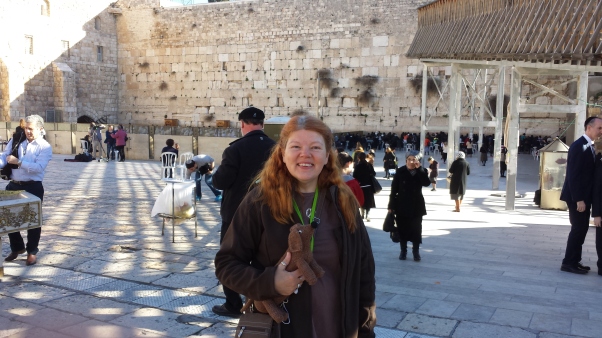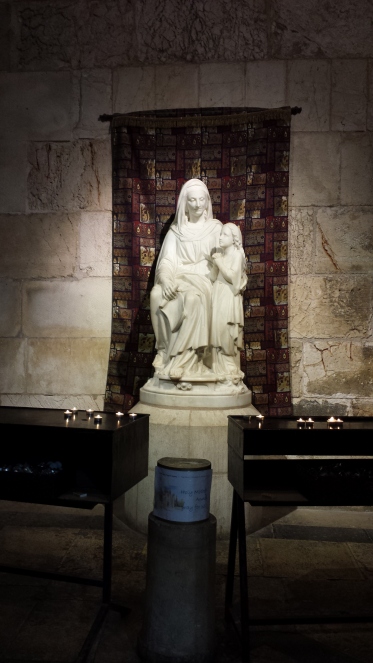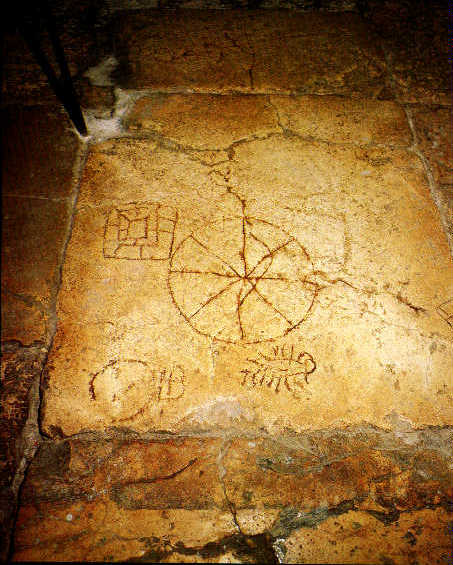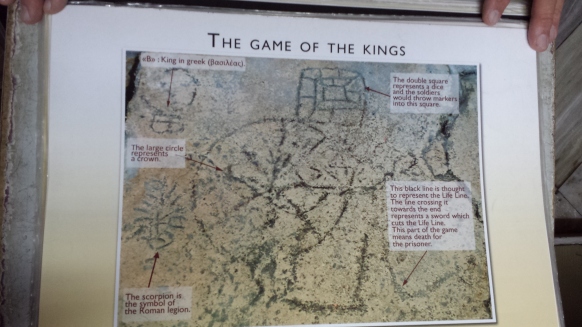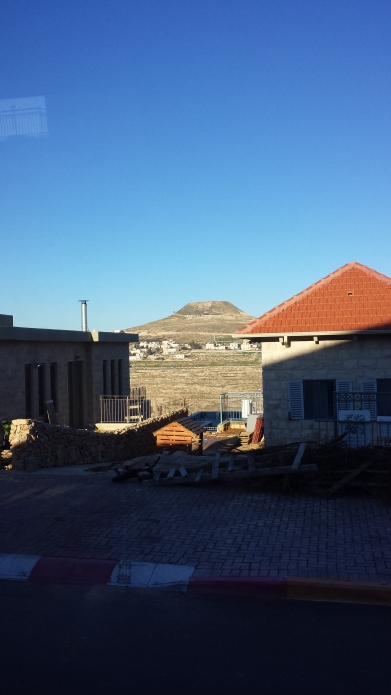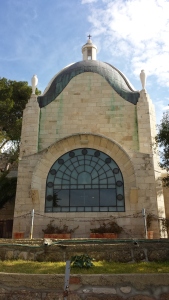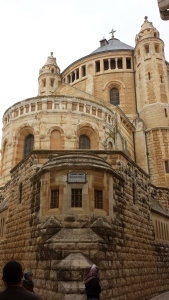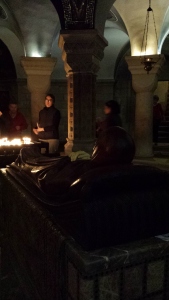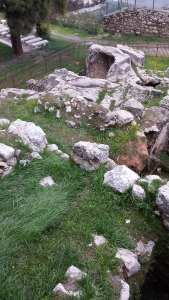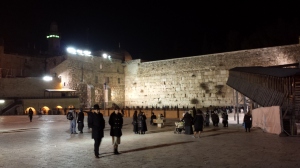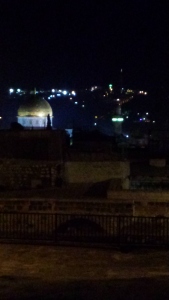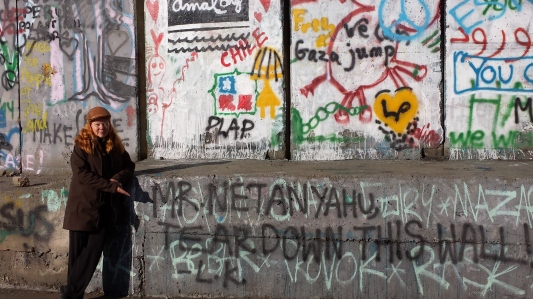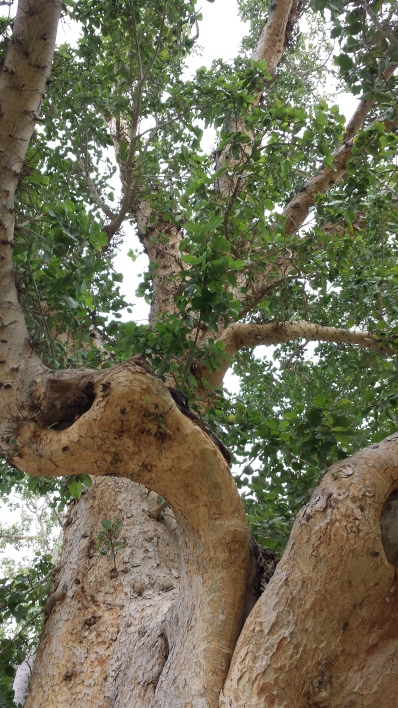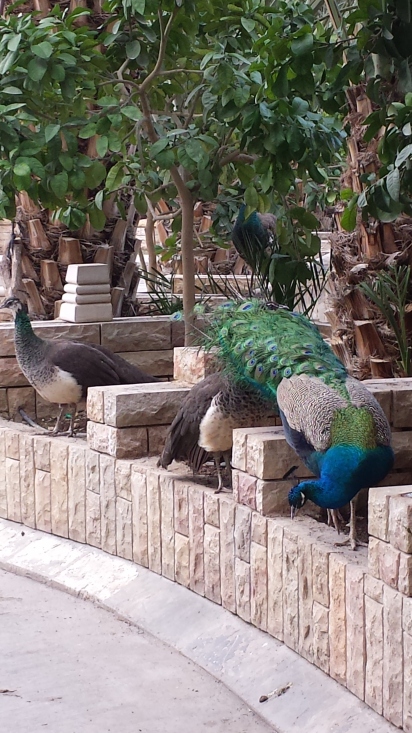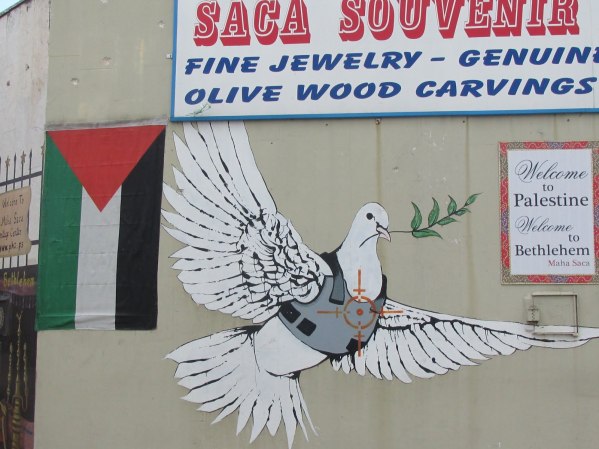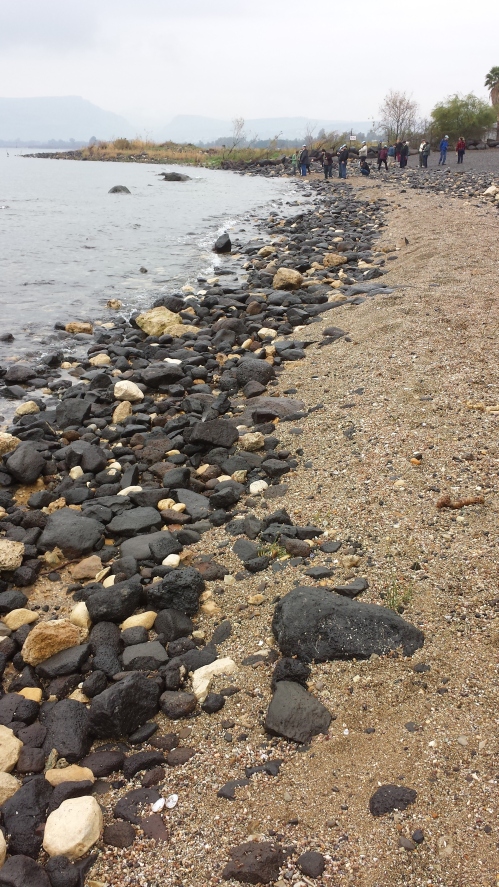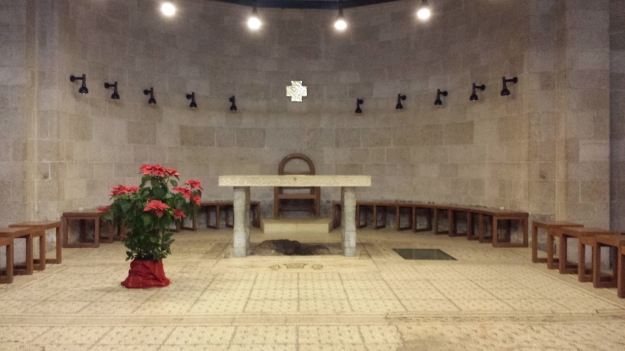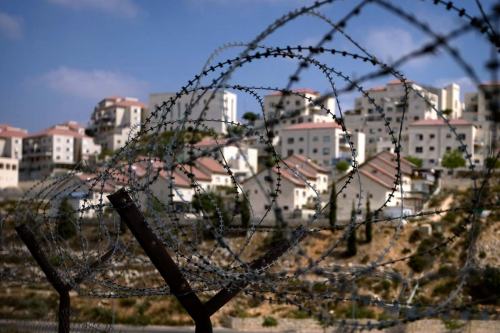
[January 26, 2015 – Middle East Monitor]. The Israeli government has approved the expansion of Efrat settlement near Bethlehem, a report in Israeli newspaper Haaretz today revealed. PM Netanyahu had previously shelved a plan to build on ‘Eitam Hill’ after international outcry following an announcement in November 2013. However, last October, the Housing and Construction Ministry allocated 850,000 shekels for the purposes of planning construction on a slope located east of Efrat and close to the southern edge of Bethlehem. The paper described the area as “a strategic target of settlers for the past decade.” Last week, Israeli forces destroyed a Palestinian wheat field at the site, which they described as ‘state land’.
“The media, with their agenda of spin, calls these ‘settlements,’” he shared, “but what they are is neighborhoods, just like any you’d see in the states, and they don’t call THOSE settlements – they’re neighborhoods! They’re suburbs! “
As we came to the check point entrance of what Bruce referred to as his “gated community,” armed Israeli guards asked Bruce a few questions in Hebrew. At certain locations on the West Bank (such as the Gush Etzion Bloc where we were), a particular Israeli Defense Forces (IDF) regulation applies. Namely, an armed guard must accompany Palestinian workers who enter the area, who live in the West Bank. Many of the workers who came to work in what Bruce called “Jewish Tekoa,” for example, lived in nearby “Arab Tekoa.” Bruce told us that he stopped into the small grocery store in Arab Tekoa from time to time – “They have good food, and the people are as nice as you’d expect to find anywhere, really.”
Though the IDF regulation did not apply in the case of our tour bus, Bruce was armed. As an Israeli citizen qualified as a security guard, he referred to himself as one of the many “Jews with guns” in his Jewish neighborhood whom Palestinian workers would call from the security gate to ask for armed escort into the area to work, in compliance with the IDF regulation.
As our bus pulled away from the checkpoint and continued its journey, Bruce assured us how wearing a gun was essential in order to provide West Bank Palestinians with work opportunities in his town – building Jewish homes, keeping their gardens and lawns, and cleaning their homes. “We love Arabs,” Bruce gleamed, “The majority of them are really fine people. Every group has people in it that want to do harm, though. So, it’s also a security issue.”
One of our pilgrims respectfully challenged the idea that all groups have those who intend to do harm, that we were a bus load of Episcopalians and a group ourselves (and wasn’t he being a little paranoid?). Bruce responded, “Thank you for reminding me that I’d better carry a gun whenever I’m with a group of Episcopalians.”
As my gut churned, I tried to focus on the landscape of the hill country passing along outside my bus window. Semi-nomadic Bedouins had once roamed the area freely, finding pasture for herds of goats and sheep, but (we learned from an earlier presentation) they were now relegated to a category of land that the Israeli army uses as firing ranges. Palestinian families, for whom the area had been home to ancestral olive groves, grape arbors and grain crops have experienced their trees chopped down and crops burned, as recently as last fall (2014) and last week (January 2015).
As I contemplated these things, trying to tune out Bruce’s ongoing narrative, the words he was currently speaking arced into my consciousness and pierced my heart, “We only build where there isn’t anything. It’s just wilderness here.”
My mind began to reel in that instant, as I recalled exactly this sentiment expressed in numerous journals and legal documents of those who colonized North America. “It’s just wilderness here – no one lives here. There was no civilization here before we came. It is God’s will that we occupy this land. These people will behave in a civilized fashion, or they will die.”
I realized that what I was hearing from Bruce was exactly the same ideological narrative that my great-grandparents encountered in the European invasion of interior British Columbia – when their people, the Shackan, had their land and resources stripped from them because all the settlers saw was “wilderness.” And Natives were a part of that wilderness, just another resource to either exploit or destroy as being in the way of real progress.
Suddenly, in my mind, I was no longer on the bus. I was reviewing once again the emotional legacy of the First Nation’s part of my family, a heritage mostly of loss. The precious bits of it, through stories and rare items, are preserved in my identity as surely as mayflies in amber. In my blood and bones, I knew how Bruce’s story would end and the role that he would play in that story for the Palestinian people of the West Bank.
I felt nauseous, sick in body and spirit. Grief overwhelmed me to such an extent that I was embarrassed by my tears and hid them from my bus mates by staring fiercely out my window. I thought of my mother and grandmother and on how they taught me that pain ought to be born in silence, without attention to the self. I could no longer hear what Bruce was saying, I was so occupied in gaining control of my feelings. However, I’ve never been especially good at maintaining that particular cultural value, especially (ironically) with regard to my Native identity and heritage.
I was surprised when the bus finally came to a stop in front of the house we had come to visit. However, because its owner, our host, had been out on a nature walk with her children, she was not home when we initially arrived, so Bruce guided our bus to the home of his ex-wife so that we could see the wind turbine roof he had designed there.
He praised the greening initiatives of his community and told us how the construction of 277 homes on a third hill in Efrat had been approved by the Israeli government as a reaction to the UNESCO’s accepting Palestine as a full member. Bruce blamed President Obama for making the Arabs work harder by having to complete the homes faster, after the US had asked for a moratorium on Israeli building in the West Bank.
When our host was finally back at her home, we returned so that we could hear more about the Israeli settler perspective. However, Bruce had told us earlier, “I don’t like the term ‘settler.’ It sounds like the American Old West idea of cowboys and Indians, as though we are somehow the cowboys invading the land and the Palestinians are the Indians. Nothing could be further from the truth! We are the Indians! We are the Indians! This is our land, and others are trying to take it from us!”
I didn’t want to get off the bus.
Mostly, I didn’t want to get off the bus, because I didn’t really want to be bawling my eyes out in front of our Jewish hosts – I didn’t want to explain myself or talk about it, nor did I think I could take on any additional interaction that would add to my emotional load. So, I asked one of group, Jesse Junior, to please go get my bishop, The Rt. Rev. Greg Rickel, who had already disembarked.
I don’t know what I wanted of him other than to explain or excuse my absence…or maybe, simply to grab on to someone and scream, “This is horse shit!” Maybe I just wanted someone to hear my tree falling in the woods.
Moments were passing, and I was the last one on the bus. I felt ridiculous and ashamed…and alone. Except there was Nael, the bus driver, who I felt even worse for than my own self, Nael having to hear and silently bear all that Bruce was saying, but having it all directed at Nael’s race.
I shook my head of tears like a sheep dog of rain water and determinedly pulled myself together. I put my face into what I hoped was a neutral setting and got off the bus. Once across the street, however, I met Bishop Greg coming out of the house towards me. I turned away from the house front, and he put an arm around my shoulders. My hastily gathered reserve gave way with equal haste.
“I’m not sure I can do this,” I confessed, “This is so horrible. It’s exactly the same. It’s exactly the same…” That’s all I could get out.
“You don’t have to do this, you know. I can…or maybe I can’t imagine…what you must be going through. You can get back on the bus, if you need to. It’s okay,” He assured me.
As I looked up hopefully, the bus drove away.
There seemed no escape, then, and I suppose the spiritually inclined part of my brain decided that God must have put me in this “opportunity” for a reason. So, then, in the next instant, I suppose that I resolved to enter into the experience fully (though I had been resisting it with every fiber of my being).
I wiped my face, set my jaw, and we went into the house. I stayed unmoving, like a wooden Indian, just inside the front door.
Our group had crowded into our hostess’ living room. Her two teenage children stood in the kitchen. She said that her husband was in their home office working on a computer problem. He never did come out while we were there. We were offered water, and Bishop Greg got some for me.
Our hostess, like the other adults we had seen in Bruce’s community, was packing heat. The handle of a handgun bulged beneath the waistline of her blowsy shirt.
She talked about her time living in California and the call she felt to immigrate to Israel and live in a settlement on the West Bank. “I like being here and wanted to raise my children here. I think anyone should be able to live wherever they want to live,” she said. By that point in our tour, I was pretty sure that she didn’t really mean anyone.
Like Bruce had before her, she spoke of the land she was on as her ancestral home, the “home of her fathers,” the place that both God and the European community (in 1948 and 1967) had promised would be the Jewish homeland.
In the household in which I had been raised, the term “Zionist” was considered impolite, and I was taught that one did not use it to apply to Jewish people. My parents considered the term to be pejorative, I think, and thereby contributing to negative and racist stereotypes. Imagine my shock, then, to hear our hosts self-describe as Zionists; to hear members of our pilgrim group apply the term openly and freely to both certain types of Jews and certain types of Christians.
Wikipedia describes Zionism as, “A nationalist and political movement of Jews and Jewish culture that supports the reestablishment of a Jewish homeland in the territory defined as the historic Land of Israel (also referred to as Palestine, Canaan or the Holy Land).” Certain evangelical Christian groups also see the return of Jews to Palestine as signaling the End Times and the return of the Messiah, so they encourage the occupation as well.
And that’s what it really is; It’s not a movement of religion, but unlawful occupation by a state, the State of Israel – an emerging nation engaging in the genocide of peoples, the destruction of homes and the appropriation of land and resources in order to create a civilization where some seem to believe none had previously existed. In such instances, religion is just a useful justification of racist crimes against humanity within a theological cosmology that judges who is among the elect and who is disposable. In short, it is colonialism.
After our time in Efrat, we went on to visit with an American Jewish lawyer. He came onto the bus, as the engine idled outside of his home, and talked about his work in land claims. At various times in his career, he represented both Israeli and Palestinian land claims. He did not see any way that the current situation could improve. His own desire was that all Palestinians should be removed to Iraq or Iran, “Where they can be with their own people – Muslims and Arabs.”
One of our group asked how he could reconcile representing both Israelis and Arabs in land claims, when it was clear that he believed that Palestinians have no legitimate claim. The lawyer raised his voice indignantly, “Lawyers represent criminals all the time. It’s our job.”
What I learned from our pilgrimage visit to the Jewish settlements and from listening to both Israelis and Palestinians who are struggling against occupation and for a solution of peace and justice is that: 1) my concerns around Israeli claims of indigeneity have been in discussion among activists and legal/political circles for decades and 2) our government is complicit in supporting exactly what’s taking place – we are in great part funding the Separation Wall that has turned the West Bank into a very large prison, and we are funding the arms of the soldiers who guard it. Meanwhile, our aid agencies are funding some of the food and medicine which gets into the West Bank.
A powerful Jewish lobby interest in the United States, known as America’s Pro-Israel Lobby (AIPAC), is funding the election campaigns of many of our congressional representatives. To go against AIPAC is to risk much, including being labeled as anti-Semitic.
However, as Rami Elhanan (one of our Israeli Jewish pilgrimage speakers) said, “Go home and tell your people that being pro-Palestine is not being anti-Semitic.”
Or, as Hanan Ashwari (a member of the Palestinian National Council and an Anglican Christian) said in our meeting with her, “The critique is not of a religion but of the actions of a state.”
The political landscape of Israel is like traveling a winding bus route through time and history. We see the impact on the land and people of the colonial powers of Britain, modern Europe and the United States. Ashwari looks to the global community for restraint of Israel and support of Palestine. She gazes intently at the land of her people through a window of war and a veil of tears. She still hopes that her colonizers will come to her aid, even as I called out for my bishop to support me. For, make no mistake, he represents the faith of a colonizing power. Yet, I think her hope – and mine – is not misplaced.
Ultimately, we are – all of us – on the bus.
Where we go from here is truly up to us.



































